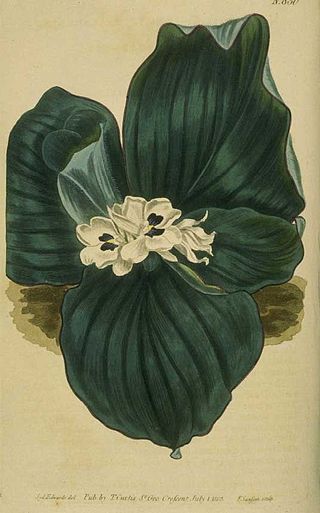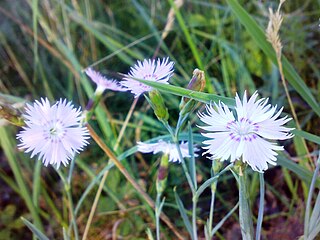
Galangal is a common name for several tropical rhizomatous spices.

Cyperus papyrus, better known by the common names papyrus, papyrus sedge, paper reed, Indian matting plant, or Nile grass, is a species of aquatic flowering plant belonging to the sedge family Cyperaceae. It is a tender herbaceous perennial, native to Africa, and forms tall stands of reed-like swamp vegetation in shallow water.

The Cyperaceae are a family of graminoid (grass-like), monocotyledonous flowering plants known as sedges. The family is large, with some 5,500 known species described in about 90 genera, the largest being the "true sedges" genus Carex with over 2,000 species.

Cyperus is a large genus of about 700 species of sedges, distributed throughout all continents in both tropical and temperate regions.

Cyperus rotundus is a species of sedge (Cyperaceae) native to Africa, southern and central Europe, and southern Asia. The word cyperus derives from the Greek κύπερος, kyperos, and rotundus is from Latin, meaning "round". The earliest attested form of the word cyperus is the Mycenaean Greek 𐀓𐀞𐀫, ku-pa-ro, written in Linear B syllabic script.
Robbins's tateril, or the Sahel gerbil, is a species of rodent found across Mauritania and possibly Mali and Niger. Its natural habitats are dry savanna and subtropical or tropical dry shrubland.

Actinostrobus arenarius is a species of conifer in the cypress family, Cupressaceae. Its common names include sandplain cypress, Bruce cypress, Bruce cypress-pine, and tamin. It is endemic to Western Australia.

The little desert pocket mouse is a species of small rodent in the family Heteromyidae. It is endemic to Baja California in Mexico.

The desert pocket gopher is a species of rodent in the family Geomyidae. It is found in the state of Chihuahua in Mexico and in Texas and New Mexico in the United States.

The sandy blind mole-rat is an endangered species of rodent in the family Spalacidae. It is endemic to Ukraine. It was first identified by Evdokia Reshetnik in 1939.

Leymus arenarius is a psammophilic (sand-loving) species of grass in the family Poaceae, native to the coasts of Atlantic and Northern Europe. Leymus arenarius is commonly known as sand ryegrass, sea lyme grass, or simply lyme grass.
A. arenarius may refer to:

Thylacodes arenarius is a species of sea snail, a marine gastropod mollusk in the family Vermetidae, the worm snails or worm shells.

The sand worm snake is a species of snake in the Typhlopidae family.

Cynoscion arenarius, sand seatrout, sand weakfish or white trout, is a species of marine ray-finned fish belonging to the family Sciaenidae, the drums and croakers. It is found in the western Atlantic Ocean. It is closely related to the common weakfish and may be a subspecies of C. regalis.

Encephalartos arenarius is a species of cycad in the family Zamiaceae. It is endemic to South Africa, where it is limited to the Eastern Cape. Its common names include Alexandria cycad and dune cycad.

Trapezonotus arenarius is a species of dirt-colored seed bug in the family Rhyparochromidae. It is found in Africa, Europe and Northern Asia, North America, and Southern Asia.

Dianthus arenarius, the sand pink, is a species of Dianthus typically found on the shores of the Baltic Sea, although there are populations elsewhere in colder areas of Europe where there are sandy soils. The unimproved species, and at least one cultivar, 'Little Maiden', are available from commercial suppliers.















